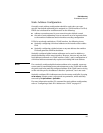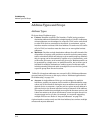
3-16
IPv6 Addressing
Global Unicast Address
Global Unicast Address
A global unicast address is required for unicast traffic to be routed across
VLANs within an organization as well as across the public internet. To support
subnetting, a VLAN can be configured with multiple global unicast addresses.
Any of the following methods can be used to configure this kind of address
on a VLAN:
■ stateless address autoconfiguration using a prefix received in an adver-
tisement received from a router on the VLAN (page 3-7)
■ stateful address configuration using DHCPv6 (page 3-8)
■ static address configuration (page 3-9)
Stateless Autoconfiguration of a Global Unicast
Address
If there is an IPv6-enabled router transmitting router advertisements on a
VLAN interface, enabling this method generates a global, routable unicast
address for the VLAN. The prefix for this address type is typically 64 bits with
the three highest-order bits set to 2.
Router Advertisements. With autoconfiguration enabled, if the switch
receives the same prefix from router advertisements (RAs) from multiple IPv6
routers on the same VLAN, then one global unicast address is configured with
that prefix. If different prefixes are received from different routers on the same
VLAN, then there will be one address configured on the VLAN for each unique
prefix received. Where there are multiple routers on the VLAN, the default
route for the VLAN is determined by the relative router priorities included in
the RAs the VLAN receives. If the highest priority is duplicated on multiple
routers, then the first RA detected on the VLAN determines the default route.
If the RA used to define the prefix for an autoconfigured address ceases to be
received on the VLAN, then the address becomes deprecated. (Refer to “IPv6
Address Deprecation” on page 3-25.)
If IPv6 is not already enabled on a VLAN when you enable autoconfiguration
on the VLAN, then the switch automatically generates a link-local address for
the VLAN as well.
If IPv6 Is Not Already Enabled. Enabling address autoconfiguration on a
VLAN when IPv6 is not already enabled on the VLAN causes the switch to:


















